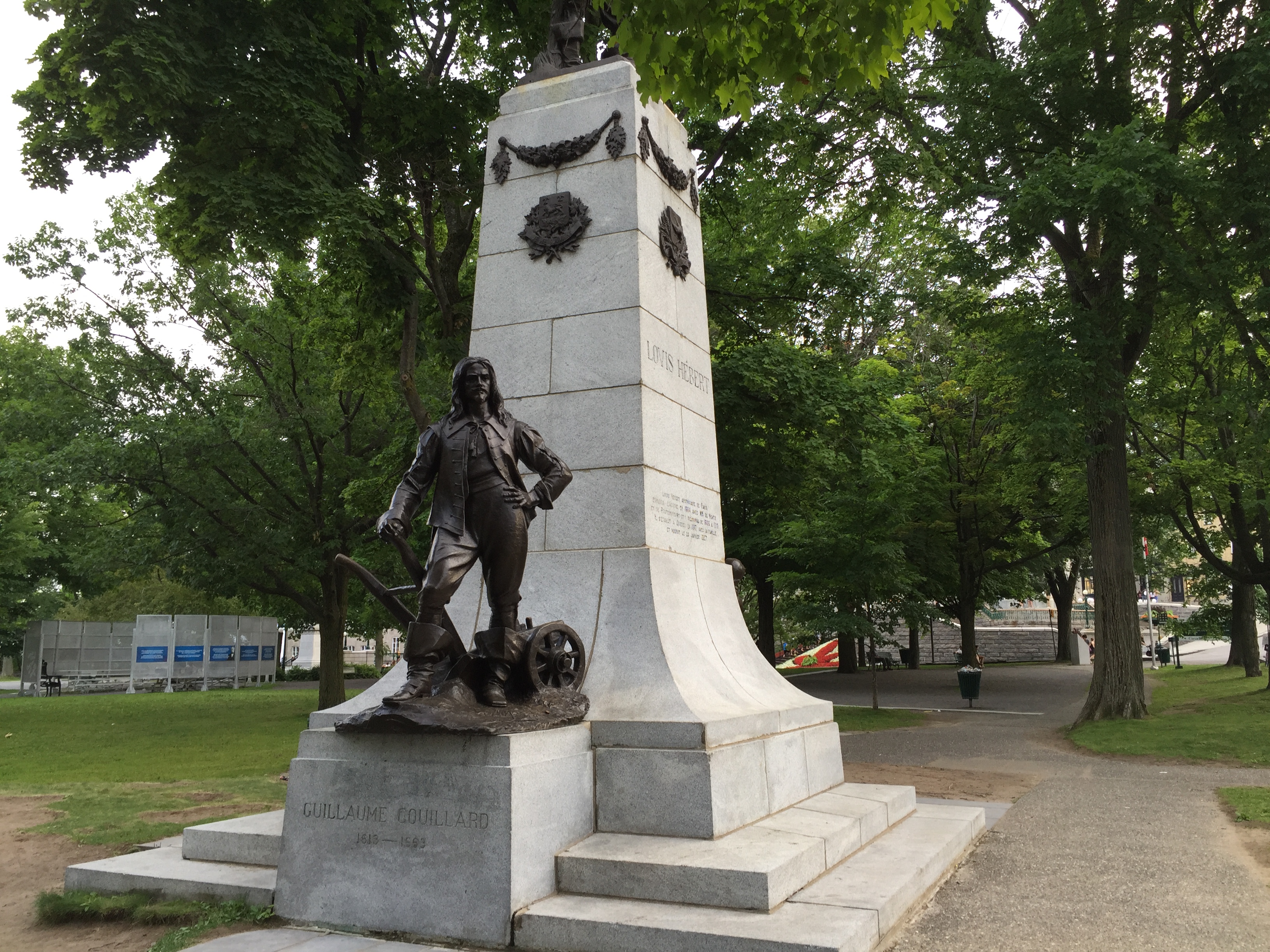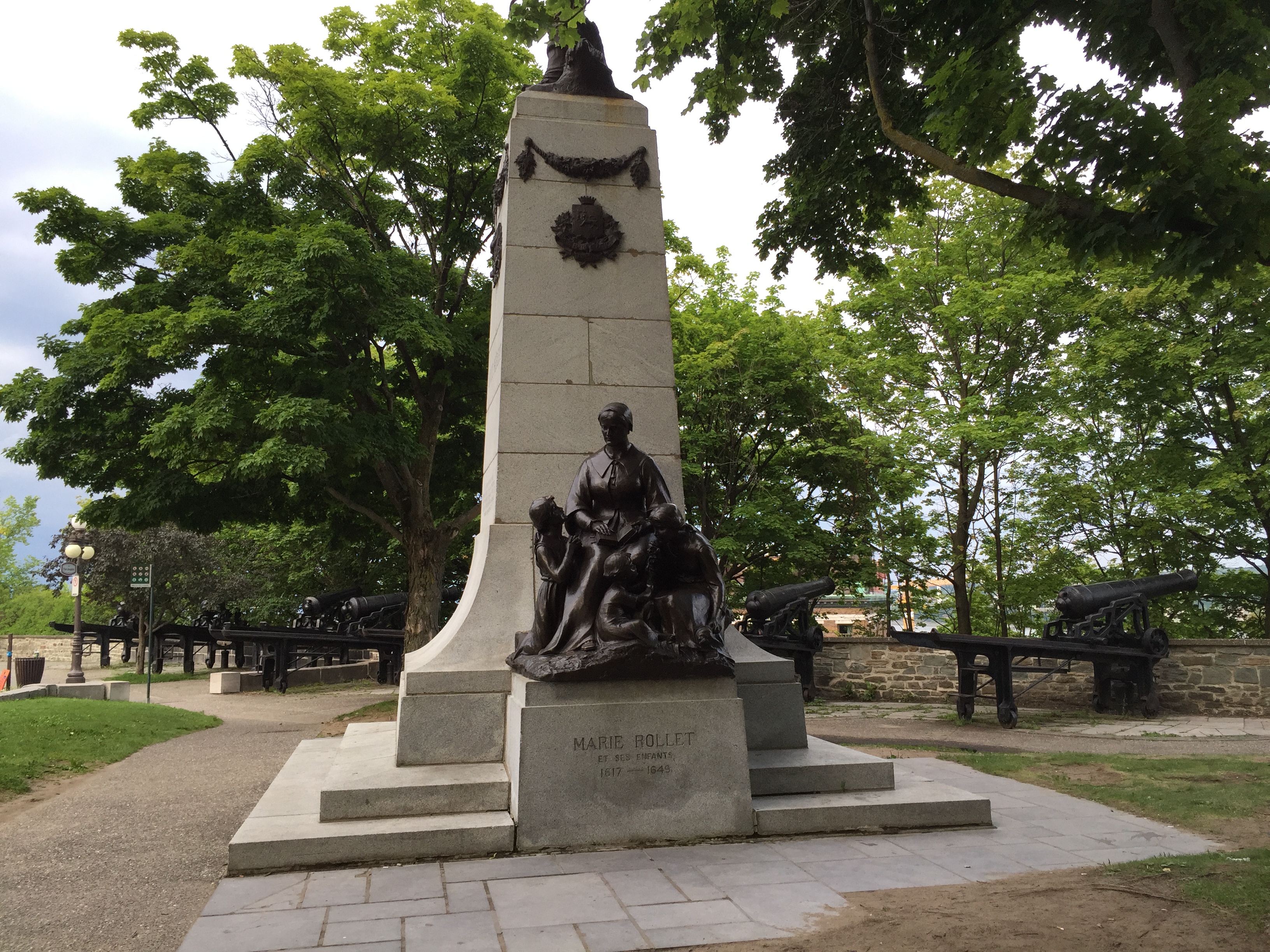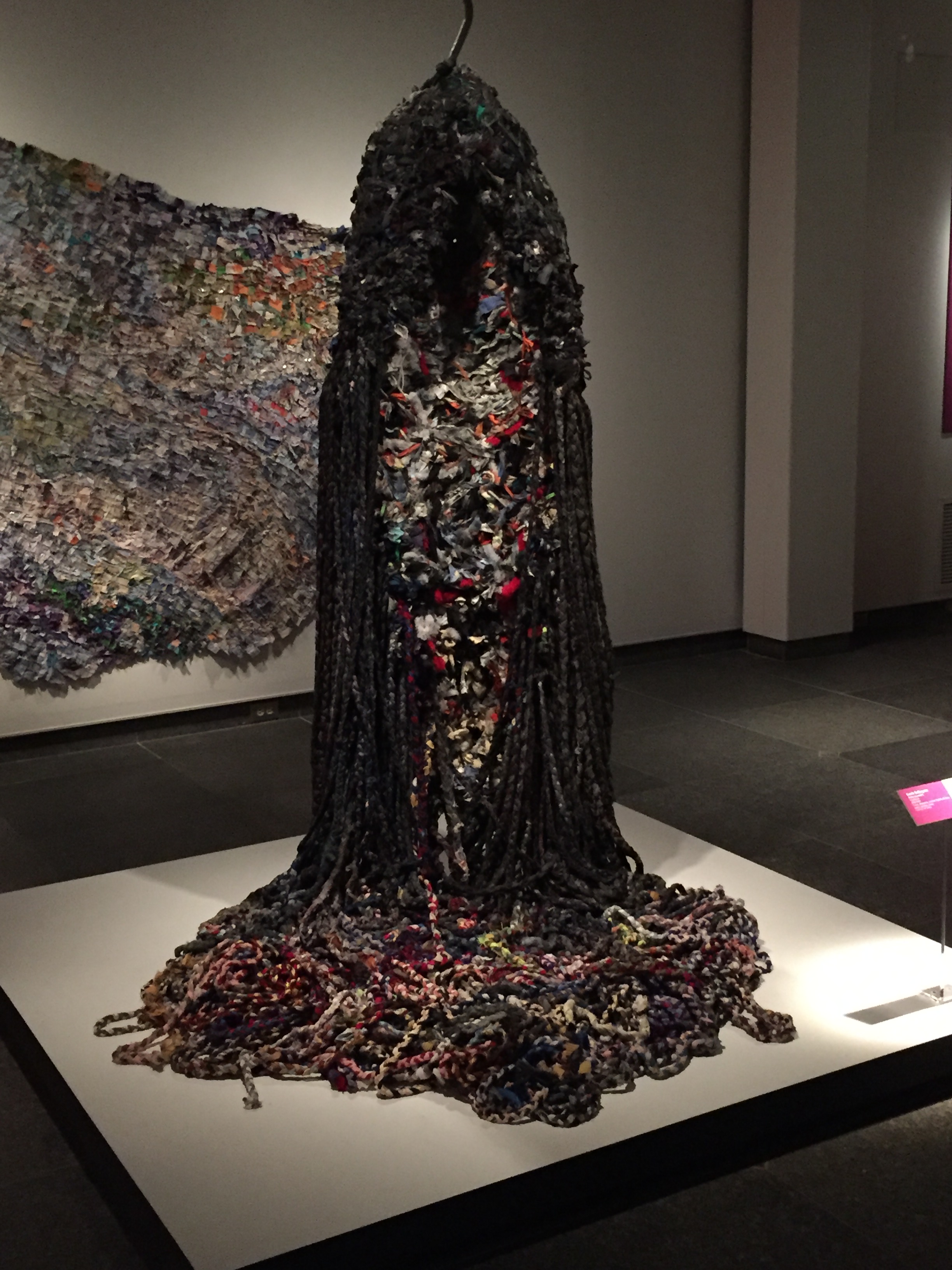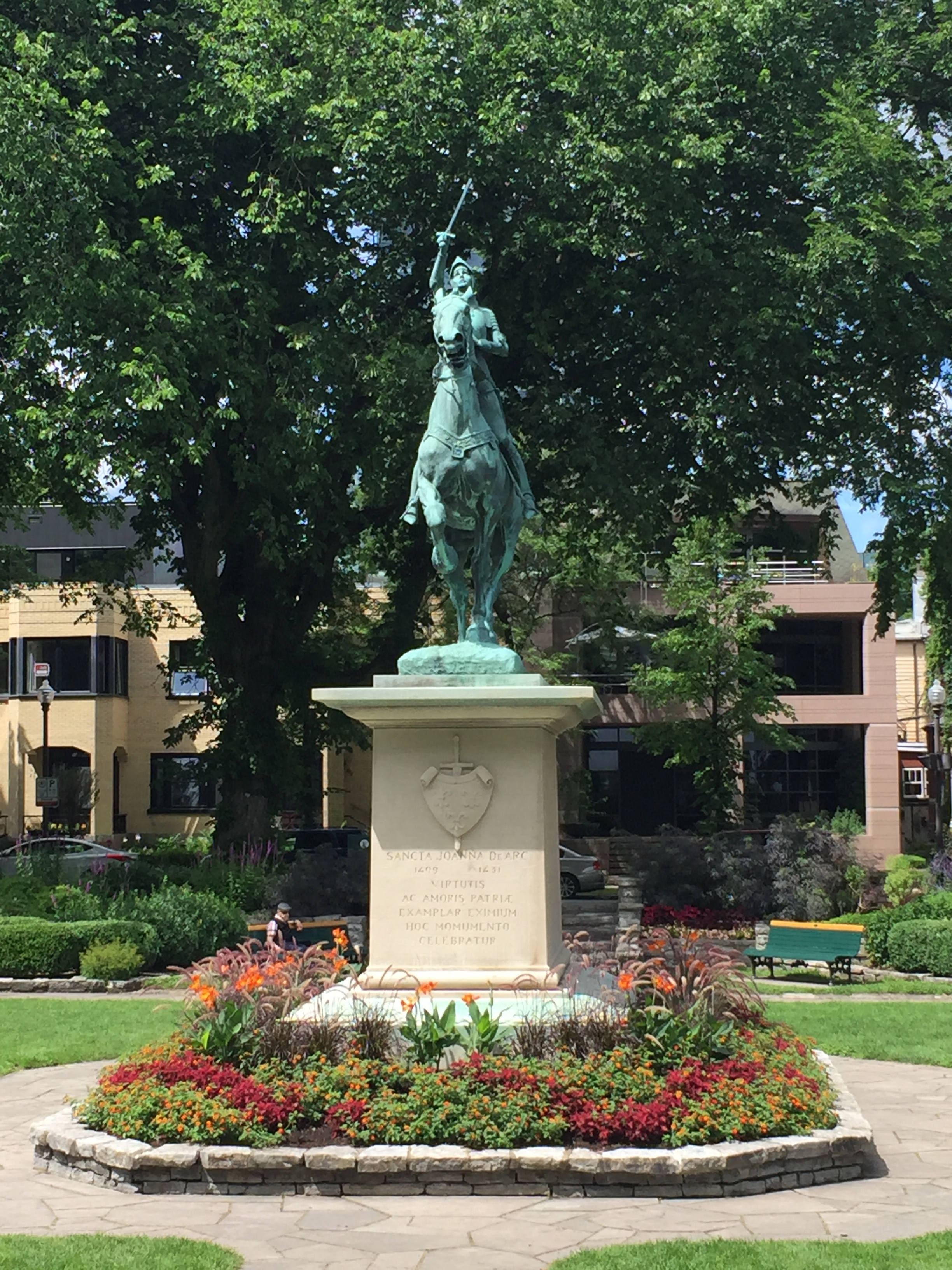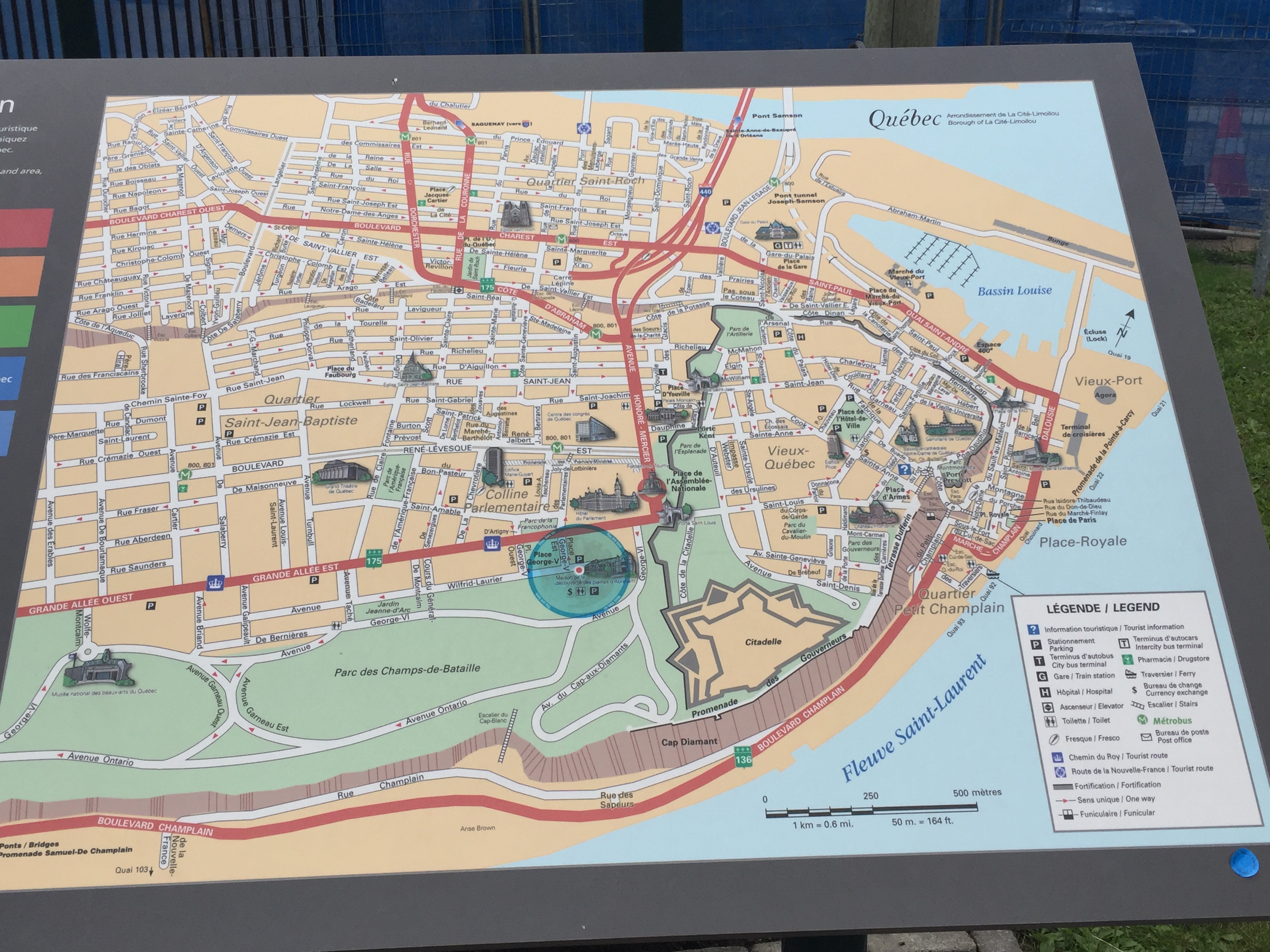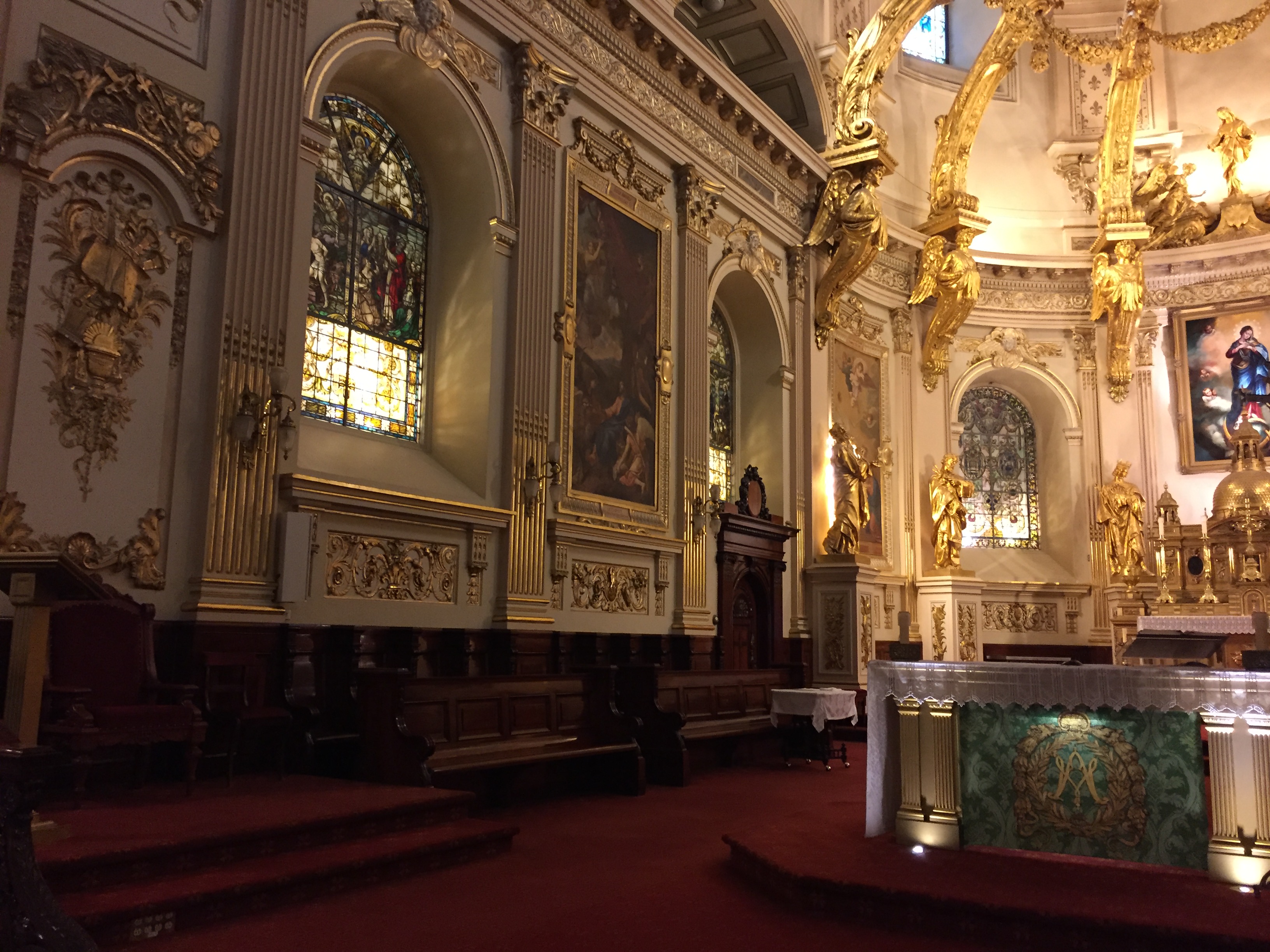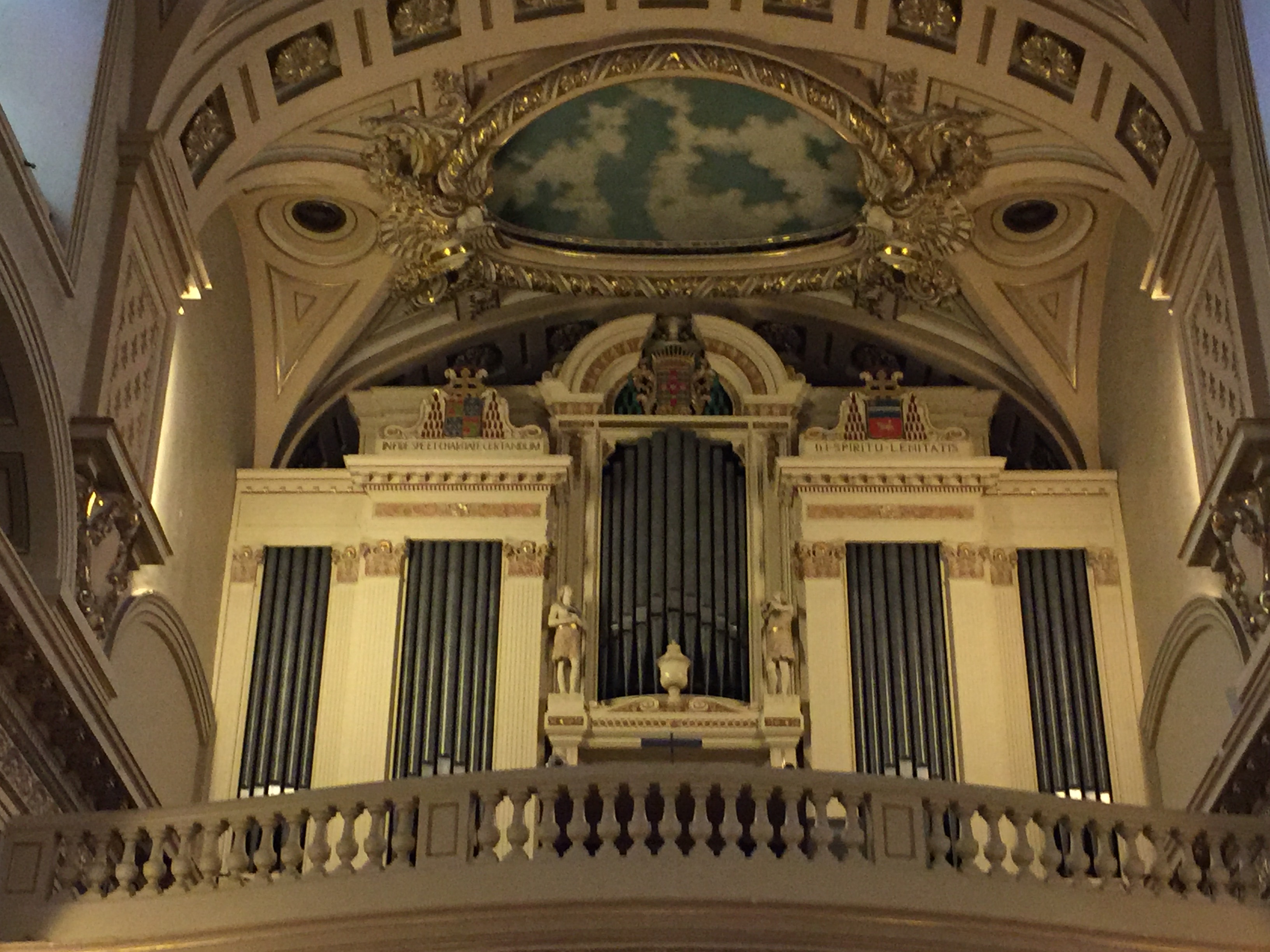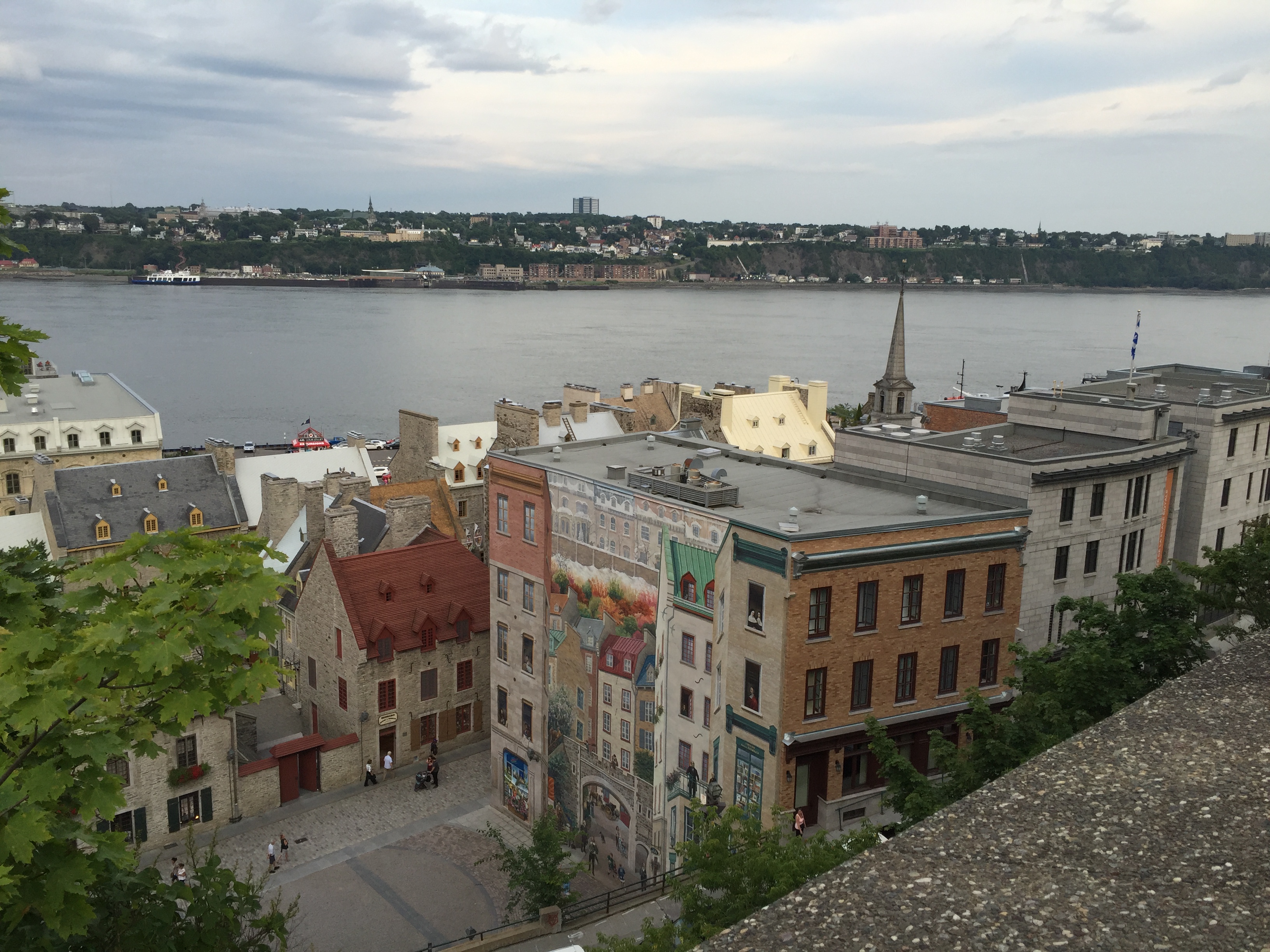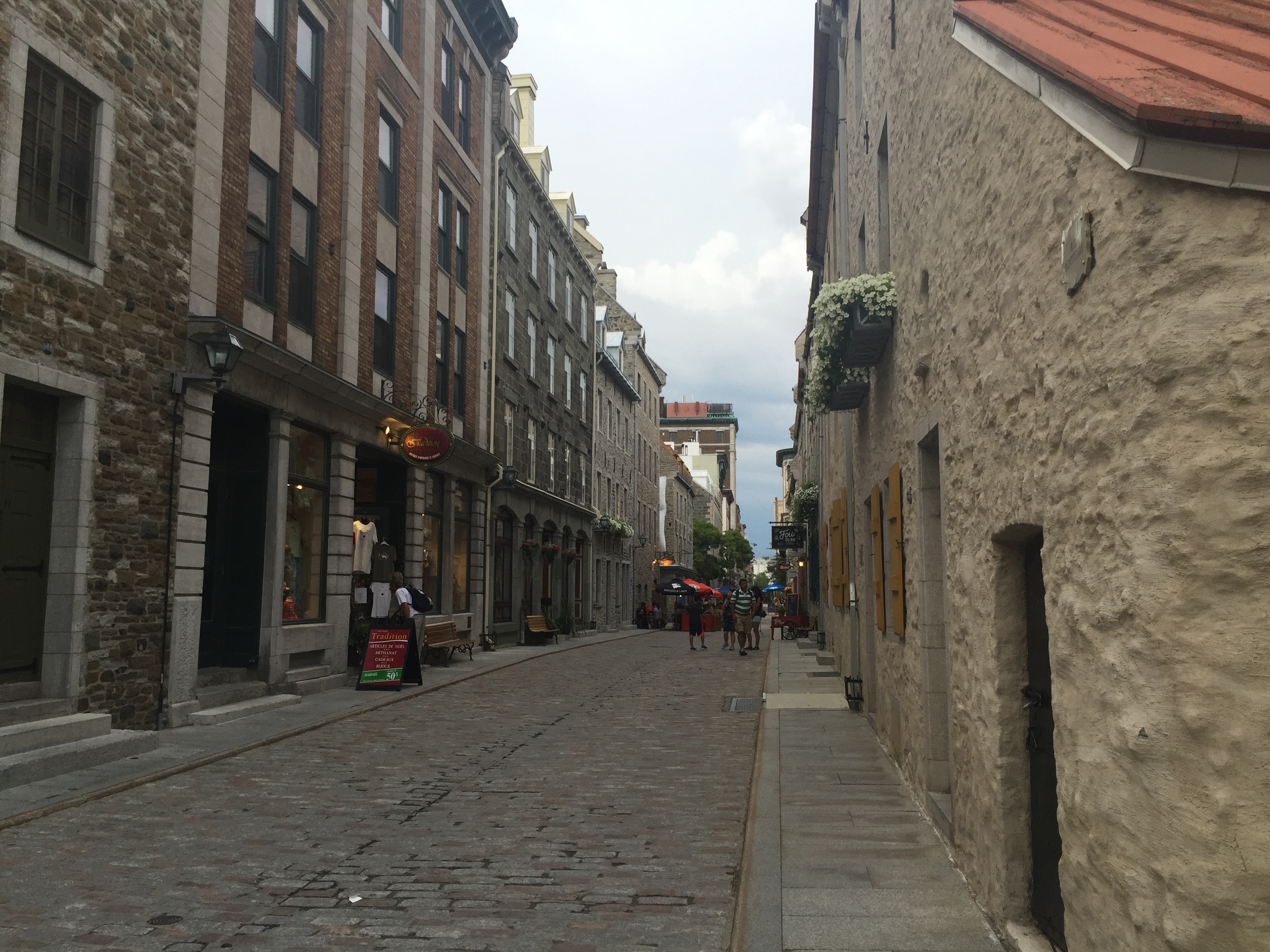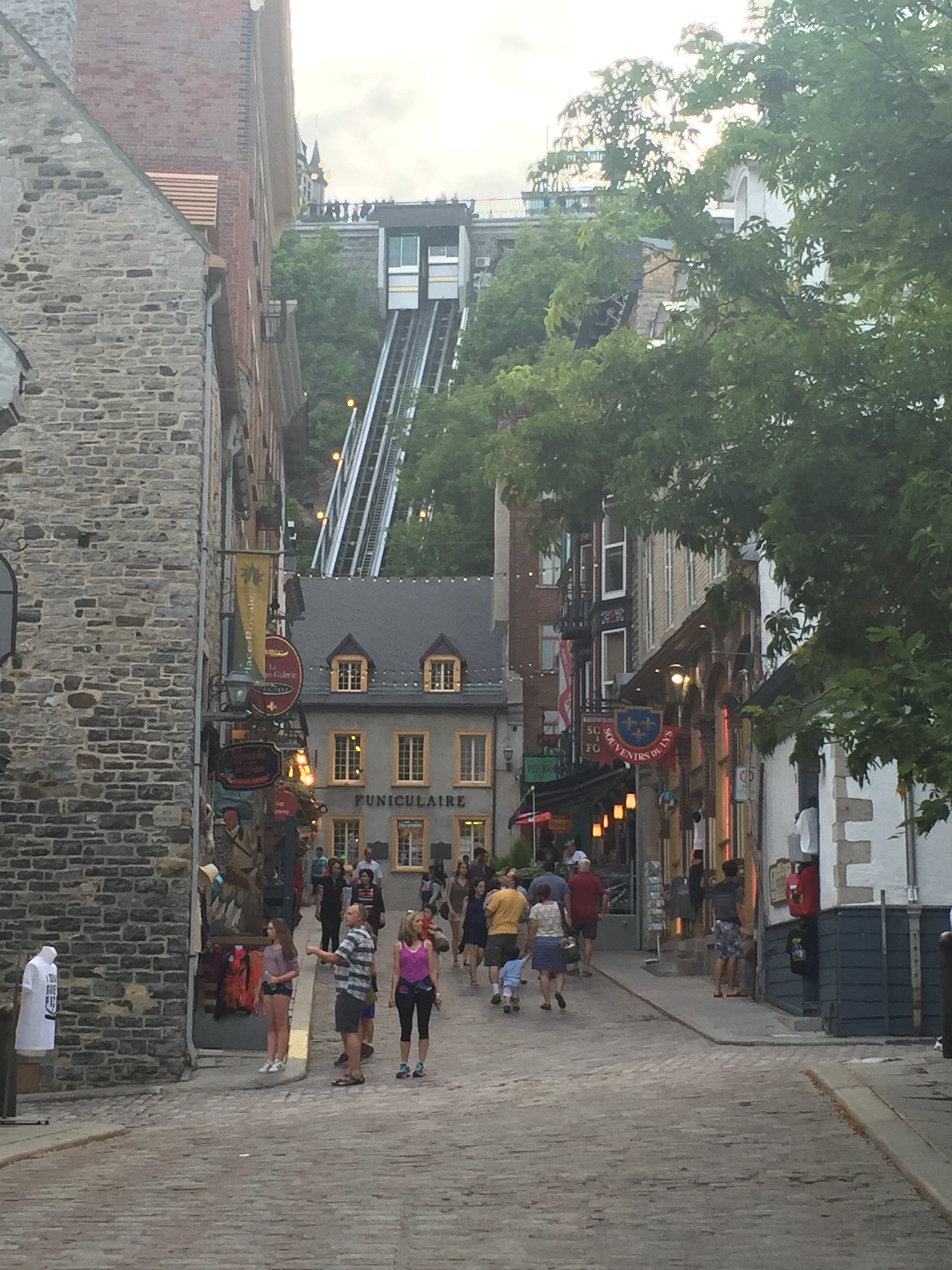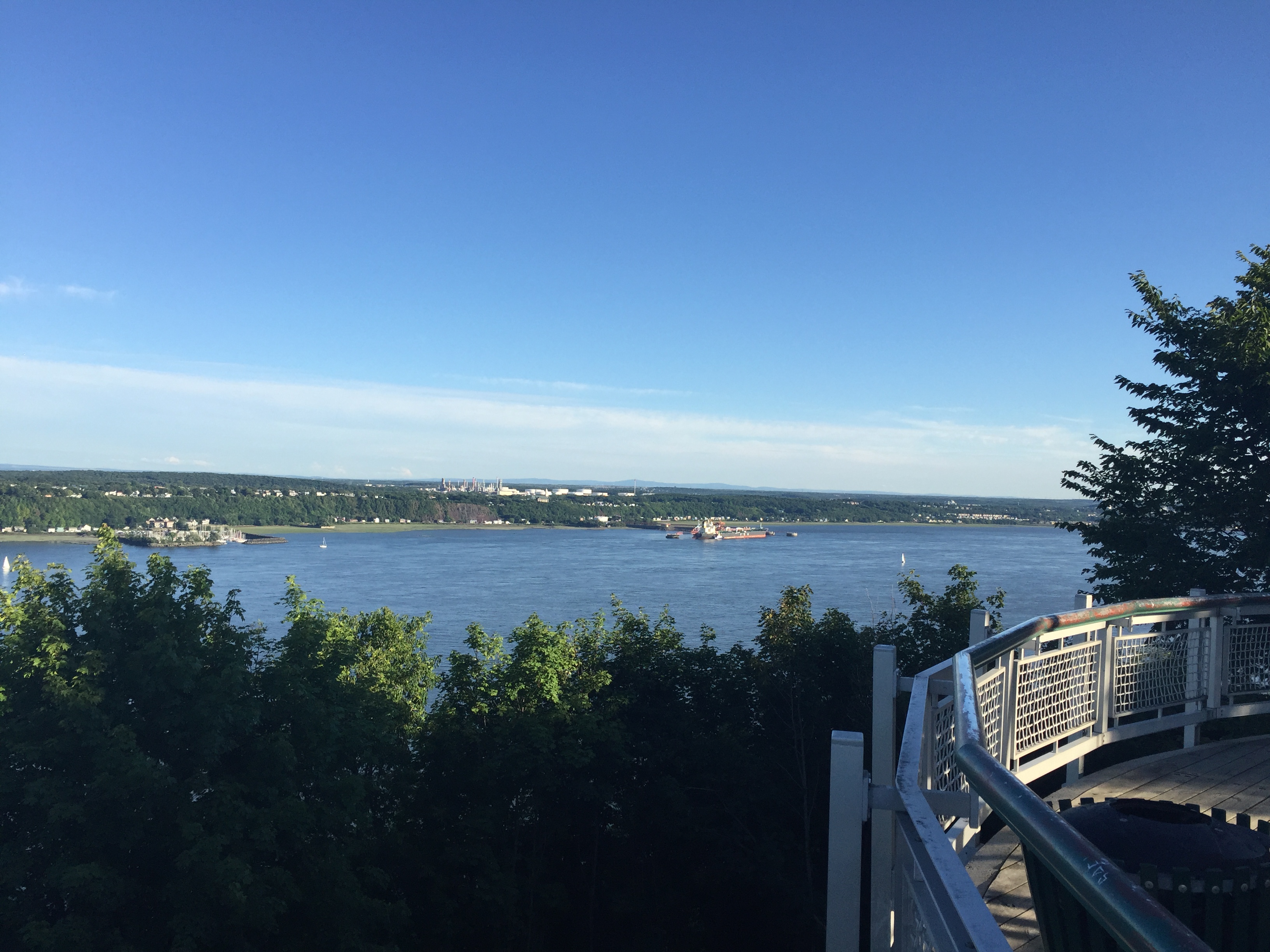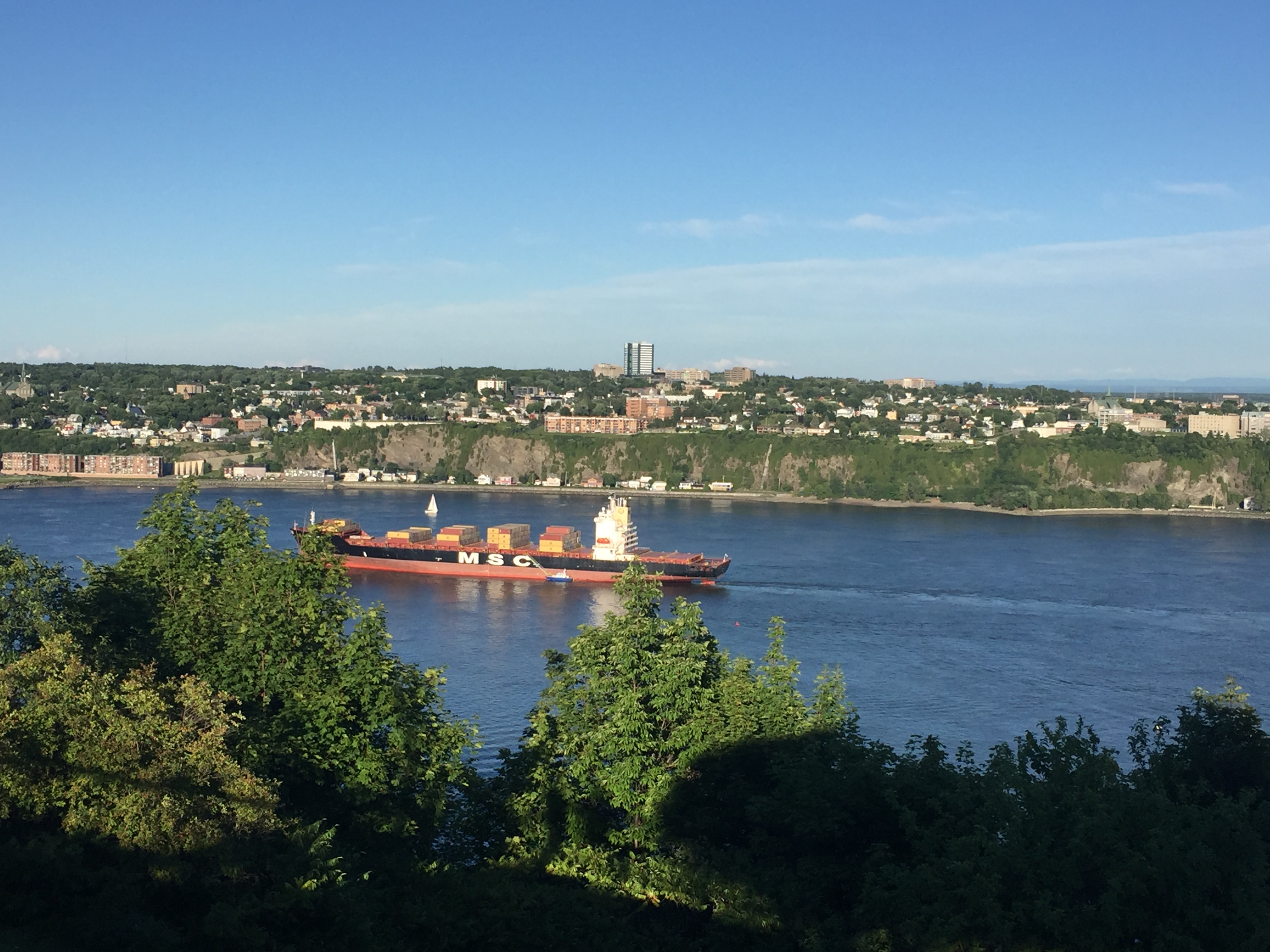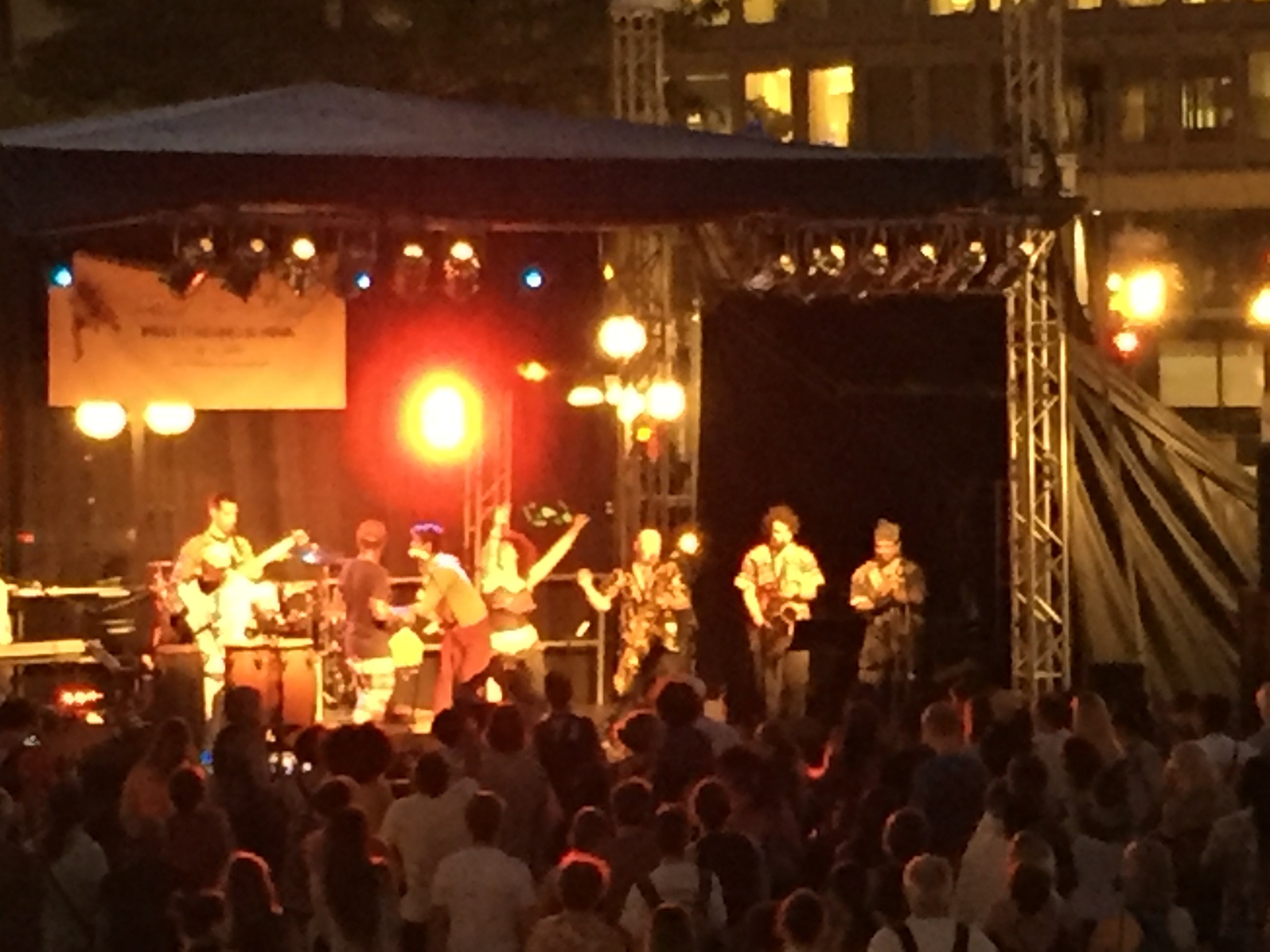CPT Visits Quebec City, Canada

August 4, 2016
During late July CPT traveled to the province of Quebec, Canada. CPT Head Trainer Mark Spivak, in a quest to expand CPT and to find multiple locations to reside and work, scheduled a 10-day visit that included both Montreal and Quebec City. A previous CPT article described our business interest in Montreal and the sites we observed in Montreal. In this article we will focus on the history, geography, climate, demographics, and economy of Quebec City that attracted us from a business perspective. We will also describe the personal highlights of our visit.
Why Consider Expanding to Quebec City?
Quebec City has many attractive features uncommon to American cities.
• First, due to the Francophone influence, Quebec City is like visiting Europe without having to cross the pond.
• Second, the French influence allows one to rapidly learn a new language via immersion while simultaneously experiencing a new culture.
• Third, the Old Quebec section is like going back in time several hundred years, whereas the government and financial sections of the city are highly modern. Therefore, one can experience both a quaint rustic European feel and contemporary conveniences and architecture.
• Fourth, Quebec has multiple collegiate and minor league professional sports teams, including the Capitales de Quebec (baseball- CAAPB), Quebec City Monarks (football- LFMQ), Quebec City Rebelles (football- LLFQ), Rouge & Our (University of Laval football), Quebec Remparts (hockey- MJHL), Quebec Phoenix (women’s hockey- CWHL), and Quebec Arsenal (women’s soccer- W League). In addition, the 18,259 seat Videotron Centre opened in 2015 to boost the city’s efforts to reacquire an NHL franchise and to obtain a future Winter Olympics bid.
• Fifth, Quebec City has outstanding parks and recreational centers, including historically relevant Battlefields Park in the city, Mont Saint-Anne, Centre d’ Aventures Le Relais, Stoneham Mountain Resort, and Centres-Ski Fond within 30 minutes of the city, and Lac Saint Charles, Lac Delage, and Lac Saint Joseph about 20 minutes from the city. Battlefields Park offers great hiking, running, and picnicking. Mont Saint-Anne has 71 ski runs in the winter, a long ski downhill and cross country ski season, and excellent hiking and mountain biking in the summer. Centre d’ Aventures Le Relais, Stoneham Mountain Resort, and Centres-Ski Fond are smaller and principally serve locals. The lakes provide swimming, canoeing, kayaking, and fishing opportunities.
• Sixth, Quebec City has multiple radio and television stations, although they are far fewer in number than in Montreal and are only Francophone.
• Seventh, Quebec City has many outstanding festivals and activities, especially throughout the summer season. The 10-stage, 11-day, 300 show, 1000 artist Le Festival d’ete de Quebec in July is Canada’s largest outdoor musical event. The 13-day, 300 artist ComediHa! Fest-Quebec in June presents celebrity and local comedic talent. Les Grans Feux Loto-Quebec offers 6 August days of spectacular fireworks shows. The New France Festival in August takes visitors back to the 17th and 18th centuries. The Grand Prix Cycliste de Quebec in September is one of only two North American stops for the UCI World Tour. The Quebec City Film Festival in September screens 50 international and 100 short films. The Quebec Winter Carnival from January through February is one of the world’s largest winter events. The Snow Pentathlon in February and March challenges athletes in 5 different winter sports. The Carrefour International de Theater de Quebec in May and June includes over 50 theater performances where spectators also receive the ability to meet creators and performers. Even outside of the highlighted events, during our trip in late July we were regaled by nightly free outdoor music shows.
• Eighth, Quebec City has outstanding restaurants, especially establishments specializing in French and native Canadian food.
• Ninth, Quebec City has excellent history and art museums. We highly recommend the Musee de la Civilisation, the Musee de l’Amerique Francophone, and the Musee National des Beaux-Arts du Quebec.
Tenth, Quebec is a fantastic walking city. For persons who enjoy exercise and can withstand the hills Quebec is a great place to put aside an automobile and travel by foot.
In summary, Quebec City is very different from any American city and well worth a visit.
History
Quebec City is highly relevant historically. The city was the location of a key battle in the Seven Years War that ultimately saw New France become British controlled Canada and ultimately an independent Canada. Moreover, the early history remains relevant in the residents’ salient maintenance of French culture and language and their periodic interest in seceding from Anglophone Canada.
First Nations tribes, mostly of Iroquois lineage, became Quebec’s first human inhabitants when they settled in the Quebec area around 2000 B.C.[1] “First Nations” is the Canadian term for the indigenous people that inhabited the Canadian provinces and territories prior to European settlement.[2] The classification is tantamount to the terminology “Native American” used in the United States.
The first European visitors, French explorer Jacques Cartier and his crew, arrived in 1535, during Cartier’s second voyage.[3] During his three voyages to the area, Cartier mapped the St. Lawrence River, established temporary settlements, and claimed the territory he called Canada in the name of French King Francis I. In 1535, Cartier and his men built a fort in Quebec City that provided them safety from the elements and the natives during the harsh winter. However, they only remained until the Spring of 1536, whereby they returned to France until Cartier’s third voyage in 1541. When arriving again in Quebec in 1541 the group built an extended settlement, but departed in 1542 due to dislike of the winter conditions and conflict with the local Iroquois First Nations tribes.
The next notable European dweller was Samuel de Champlain, nicknamed “The Father of New France.” Champlain was a noted cartographer who improved upon Cartier’s maps of the Atlantic and Saint Lawrence coastlines. In 1608, during an expedition funded by entrepreneurial New World fur trader Pierre Dugua de Mons and supported by King Henry IV, Champlain founded Quebec City adjacent to an abandoned Iroquois village.[4] Champlain initially named the colony L’Habitation.[5] At this time the “city” consisted of 3 two-story wooden buildings, a stockade, and a moat. Subsequently, Champlain traveled about the present-day Quebec and Ontario provinces to explore and map the New France territories. However, in 1620 he returned permanently to Quebec City, where he remained the administrator of New France until his death in 1635. During the period from 1620 to 1635 Champlain built the first of the city’s famous stone fortifications, constructed Fort Saint-Louis within the city boundaries, and negotiated trade relationships with trappers, French colonists, First Nations tribes, and France.
During Champlain’s period there was a brief time where Quebec City converted to English control. In 1629, during the Thirty Years War (1618 – 1648), a great religious conflict (Roman Catholic expansionist vs. Protestant) that fomented war between a majority of European countries, including England, France, Bavaria, Saxony, Spain, the Netherlands, Sweden, Denmark, Poland, and Russia,[6] brilliant military strategy led to the peaceful Surrender of Quebec.[7] A French émigré who relocated to England, David Kirke, led an expedition on behalf of English King Charles I to wrest control of “Canida” from France. Kirke captured supply ships destined for Quebec City, then later demanded that the famished city surrender, which it did without a battle. However, in 1632 Champlain protested convincingly that the English seizure was illegal, as the European conflict between England and France had ended (England’s involvement in the Thirty Years War was only from 1619 – 1622 and then again from 1624 – 1630 and the Anglo-French portion of the War was only from 1627 – 1629[8]) prior to Kirke’s actions. Thus, later in 1632, within the Treaty of Saint-Germain-en-Lay, Charles I returned Quebec and Acadia to French control under the flag of King Louis XIII. This was the first of many conflicts between England and France that determined the ultimate control of Quebec.
Upon the passing of King Louis XIII in 1643 the throne converted to his son, Louis XIV, also known as “Le Roi Soleil,” “The Sun King.”[9][10] King Louis XIV wished New France to become the focal point of France’s colonial expansion. Therefore, he encouraged settlement, including immigration by single commoner women, known as “les filles du roi” or the “King’s Daughters,” so that they may marry and propagate to further expand France’s penetration of the New World.[11]
In 1663, Quebec City was named the capital of New France. At this time the population of the settlement and its adjacent agricultural territory had grown to almost 2,000 people.[12] In 1673, under the command of the Governor General of New France, Louis de Buade de Frontenac,[13] above the Cap Diamant promontory construction began on La Citadelle de Quebec.[14] Construction completed in 1690. The Citadelle was a fortification to provide defense from invaders approaching up the St. Lawrence River. Interestingly, La Citadelle remains an active military installation and the residence of the Governor General of Canada. La Citadelle and its multiple adjoining buildings are a major tourist attraction, the oldest military complex in Canada, and a major portion of the overall fortifications of Quebec City. Of note to tourists, Quebec City and Campeche, Mexico are the only North American cities still encircled by fortifications. From the standpoint of military history, strategically the immobile battlements and cannons of La Citadelle proved as ineffective against the English as the imposing, but inflexible fortresses and artillery of the Maginot Line were against the Germans in World War II.[15]
Quebec City remained peaceful until the Battle of Quebec in 1690.[16] The Battle of Quebec was fought within King William’s War (1688 – 1697), also known as the Second Indian War or the First Intercolonial War,[17] which was part of the Nine Year’s War, which is also called the War of the Grand Alliance or the War of the League of Ausburg.[18] The Nine Year’s War was fought between France and an alliance of opponents that included England, Austria, the Holy Roman Empire, Spain, the Dutch Republic and Savoy, who attempted to curtail Louis XIV’s expansionist goals after he revoked the Edict of Nantes, which led to the French persecution and forced conversion of Huguenots,[19] and ordered his army across the Rhine into the territory of the Holy Roman Empire (which dissolved in 1806, but at the time was comprised mostly of present-day unified German states, western French states, the Czech Republic, and northern Italy).[20] King William’s War was the North American theater of the conflict between France and England. The conflict was spurred by expansionist goals on the part of both parties, an increasing amount of English settlers in New England and the adjacent colonies, English colonialist alliances with the Iroquois, who interfered with the French trapping trade, and religious enmity between the French Catholics and the predominantly Protestant English. The Battle of Quebec tested the fortifications of Quebec City, including La Citadelle. Although English settlers in the New World outnumbered French settlers 154,000 to 14,000, the English expedition from the Massachusetts Bay Colony into Acadia and Quebec was poorly supplied and financed. Consequently, the Quebec City walls and cannons combined with superior French military strategy repelled the English naval and ground invaders led by Sir William Phips.
There was not a significant battle fought inside the land territory of Quebec City until the Seven Year’s War (1754 – 1763). However, France’s defeat in Queen Anne’s War (1702 – 1713), also known as the Second Indian War, where in The Treaty of Utrecht they seceded Newfoundland and Acadia (present-day Nova Scotia) to the British, forebode what was to come.[21]
The Seven Year’s War was perhaps the first truly intercontinental world war involving European countries. The war, which started over disputed English and French territorial boundaries, included England, France, Spain, Portugal, Prussia, Austria, Saxony, and Russia as the major combatants, along with several minor combatants, who either supported allies, used the war as an opportunity to further expansionist goals, or were forced to defend territory from invaders. Upon the conclusion, in the Treaty of Paris, France not only lost New France/Canada to England, but also ceded Louisiana and all territories west of the Mississippi River to Spain.[22]
The North American portion of the Seven Year’s War is called the French and Indian War in the United States and the War of the Conquest in France.[23] During the war three key battles were fought in Quebec City, the Battle of Beauport, the Battle of the Plains of Abraham, and the Battle of Sainte-Foy. The Battle of Beauport in July 1759 started when British General James Wolfe attacked from a northern landing by Montmorency Falls.[24] However, the French militia commanded by General Louis-Joseph de Montcalm,[25] aided by a severe thunderstorm that wet the British gunpowder, successfully defended the city, with the British suffering 10 times the casualties of the French.
The Battle of the Plains of Abraham is considered the most historically significant of the three battles.[26] After Wolfe’s retreat in July the English commenced a three-month siege and bombardment of heavily fortified Quebec City. The English aggression culminated on September 13, 1759 when a well supplied Wolfe committed a daring landing and military strategy that totally outwitted Montcalm. To prepare for the battle Wolfe’s soldiers raided outlying French farmers. Concurrently, the English Navy blockaded French ports and limited maritime access in the Saint Lawrence River. Wolfe became frustrated as Montcalm failed to leave the city gates to launch an offensive attack to disrupt the siege. To end his frustration, Wolfe planned a surprise landing at L’Anse-au-Foulon, a cove approximately 3 kilometers south of Cap Diamant. Wolfe’s troops arrived on dinghies at night at the foot of a 174-foot nearly vertical cliff. They then climbed the cliff, had a small party masquerade themselves as French troops from an expected supply convoy, had those troops overpower a French reconnoitering party, hiked in silence several miles to the Plains of Abraham that adjoined the city, assembled on the pasture adjacent to the cliffs, and upon daybreak awaited battle with Montcalm’s militia. Meanwhile English Admiral Charles Saunders commanded a diversionary force from Montmorency, north of the city. Once Montcalm received word that Wolfe’s forces awaited him south of the city, rather than wait for reinforcements from troops garrisoned along the shore, Montcalm elected to meet Wolfe’s challenge. Wolfe ordered his men to align in a two-deep horseshoe approximately 1 kilometer long. After some brief skirmishes with hidden French troops accustomed to guerilla warfare, Wolfe commanded his men to cease fire and lie down within the high brush of the fields. Montcalm then ordered his men to attack. Montcalm’s poorly trained troops fired beyond the distance of their muskets and failed to cohesively organize their fire to take advantage of the concentrated fire strategies most effective during the period. While the French fired haphazardly Wolfe had his men patiently wait until the opponents were within 30 yards, whereby his men fired in unison. Wolfe also instructed his men to load their muskets with 2 balls. The British volleys fired collectively seriously damaged the French lines and quickly instigated their retreat. The British then pursued the fleeing French troops. Each side lost approximately 650 men and their leaders. Both Wolfe and Montcalm succumbed to battle wounds. Several days later the French abandoned Quebec City. Then, from land and sea the British besieged the persons that remained within the ramparts. On September 18, the Governor of New France, Pierre de Rigaud, Marquis de Vaudreuil-Cavagnial,[27] formally surrendered the city in the Articles of Capitulation of Quebec. From that moment Quebec City had fallen permanently under English control.
The battle of the Plains of Abraham is probably the most significant historical event that has shaped modern Quebec City. The preceding statement is supported by the large number of museums and historical sites extolling Wolfe’s genius and the British victory. During our visit, I ran along the steep trail that duplicated the climb and hike of Wolfe’s troops. The trail included many placards dedicated to celebrating Wolfe’s military strategy and courage. In addition, Battlefields Park,[28] Quebec City’s largest park, is situated on the Plains of Abraham. The park includes 50 historical artillery pieces, battlements, and a museum dedicated to the park’s history. Nevertheless, many within the predominantly Francophone population resent the glamour the Canadian government attaches to the battle.
The Battle of Sainte-Foy[29] in April 1760 was the French army’s last attempt at regaining control of Quebec City. Scurvy had reduced the size of the English garrison. The Chevalier de Levis marched 7,000 French militiamen and First Nations allies to encounter the 4,000 remaining British occupiers. English General James Murray ordered his men to meet the approaching French on the Plains of Abraham. Although outnumbered, the British cannons and muskets held their own until the men ran low on ammunition after supply transports became stuck in the snow. Consequently, the English abandoned their cannons and retreated quickly inside the city walls. Levis and his men then commenced a siege of Quebec. However, the English broke the siege when warmer May weather destroyed icepacks on the Saint Lawrence River, which allowed supply ships to rearm the city and reinforcements to increase the ranks. Moreover, the French armada was drastically reduced in size due to catastrophic losses at Quiberon Bay,[30] off the coast of France, and in the Battle of Restigouche,[31] fought on The Restigouche River between southeastern Quebec and present-day New Brunswick. The French naval defeats restricted the ability of the French to reinforce and resupply Levis’s army. Thus, although absorbing military defeat in the Battle of Sainte-Foy, the English were still able to maintain control of Quebec City.
I realize that the above history has little or nothing to do with dog training. Nevertheless, I find the history fascinating, especially how differences in religion, language, and culture fomented enmity that resulted in frequent hostile military conflict. In addition, before we seriously consider expanding CPT to Quebec province we must first understand the people that inhabit Quebec- and the history of Quebec City greatly influences the attitude of the people. Moreover, as Spanish philosopher and essayist George Santayana wrote, “Those who cannot remember the past are condemned to repeat it.”
The next stage of Quebec history deals with conflict between the British rulers and invading American revolutionaries. After the Seven Year’s War victorious England was heavily in debt from financing the military effort. As a result, to mitigate the debt and to offset the cost of operating the 13 colonies, which earned comparatively few revenues and created a huge and expanding deficit, English parliament levied customs taxes on the colonists. Patriots within the colonies then revolted against what they believed were inequitable British taxation policies.
The British North America Act of 1774[32] was an attempt by the English government to appease Quebecois, as the English parliament was concerned about potential rebellion in Quebec coinciding with the uprisings occurring in New England and the rest of the 13 colonies. The Act increased the territorial size of Quebec province, removed mention of Protestantism from the oath of allegiance to the King, provided freedom to practice the Catholic faith, allowed Catholics to hold public office, allowed freedom to practice the French language, allowed a Seigneurial system of land management, allowed the implementation of French civil law for private matters while maintaining English common law for legal proceedings relevant to public law, and allowed the Catholic Church to institute tithes. However, Protestant English Canadians and New Englanders were upset with the Act’s acceptance of the Catholic religion and the expansion of Quebec to land that includes present-day Ontario, Illinois, Indiana, Michigan, Ohio, Wisconsin, and northern Minnesota. Furthermore, many American patriots took umbrage after supporting the King’s army during the Seven Year’s War, as the Americans strongly disagreed with the apparently favorable treatment English parliament provided its former enemy. Distress about the Act prompted the attempted American invasion of Quebec during the American Revolutionary War (1775 – 1783).[33]
The Battle of Quebec ensued in December 1775.[34] Major General Richard Montgomery, a converted British soldier, captured Montreal for the Continental Army and then joined Benedict Arnold’s forces while heading northeast toward Quebec City. The American effort started with a 30-day siege, progressed to artillery fire, and then finalized with an attempted nighttime scaling of the city walls. However, a fierce snowstorm, insufficient reinforcements and supplies during the march, hunger, fatigue, and a lack of expected support from French Canadiens proved to be insurmountable obstacles. The Continental soldiers were captured, fled, or formally retreated. Montgomery was killed and Arnold was wounded. Subsequently, Arnold and his depleted army attempted a prolonged siege of the city. However, brutally cold temperatures, inadequate supplies, smallpox, and the expiration of enlistments could not overcome the well-stocked Quebecois safely ensconced within the city walls. Upon the arrival of British naval and ground reinforcements in May, the English took the offensive and drove the Americans all the way to Fort Ticonderoga. Subsequently, the Quebec provincial governor, General Guy Carleton, proceeded to punish any Quebecois that assisted the Americans. Resultantly, Quebecois became hesitant to support the American patriotic cause. There was only one other major battle, The Battle of Trois-Rivieres,[35] fought on provincial soil and no other battles as far north as Quebec City.
At the conclusion of the Revolutionary War, upon the signing of the Treaty of Paris in 1783,[36] a border was established between the United States of American and Canada.[37] The boundary was a combination of land and sea. The land boundaries included the 45th parallel between New York state, present-day Vermont, and present-day Quebec province and the northern Appalachian mountains along eastern Quebec and New Brunswick. The sea boundaries included the Great Lakes and the St. Lawrence River for western areas bordering present-day Ontario province and Beau Lake and the Saint John River, Chiputneticook Lake, the Saint Croix River, Passamaquoddy Bay, and the Bay of Fundy for eastern areas bordering New Brunswick.[38]
Upon the conclusion of the Revolutionary War, the subsequent stage of Quebec City history surrounds the relationship between Anglophone and Francophone residents and British governmental attempts to manage both groups. The English government controlled the territory. There were English military installations. Anglophone residents included English speaking Canadian settlers and an influx of former American colonists. The referenced expatriates maintained loyalty to England through the war and afterward fled to Quebec province upon the British defeat. However, Francophone residents still significantly outnumbered Anglophone residents.
The Constitutional Act of 1791[39] was an attempt to appease the interests of both the English and French settlers. The Constitutional Act of 1791 replaced the British North America Act of 1774. The Constitutional Act divided Quebec province into Upper Canada to the west (present-day southern Ontario) and Lower Canada to the east (present-day Quebec). Upper Canada operated in accordance with English law, whereas Lower Canada operated per French law and customs. Concomitantly, each area constructed separate governmental bodies and Quebec City became the capital of Lower Canada. Although the act temporarily mitigated cultural disputes, there are historians who believe that the establishment of a distinctly French area catalyzed the periodic quests for independence that still occur in French-speaking Quebec.
Quebec City remained peaceful and prosperous for the next several decades. The city became the third largest port in North America and the economy flourished from the lumber industry.[40]
Even the War of 1812 (1812 – 1815)[41] had little effect on Quebec City.[42] During the War of 1812 the United States briefly invaded Upper Canada and southern Lower Canada in an attempt to acquire Canadian lands. However, the American forces were repelled. Upon the conclusion of the war and the signing of the Treaty of Ghent, boundaries returned to their pre-war geographies. Nevertheless, due to concern of a future American invasion, the government expanded La Citadelle de Quebec. Yet, the extra fortifications proved unnecessary. The War of 1812 was the last military conflict between the USA and Canada.
Provincial peace was interrupted in 1837 during the Lower Canada Rebellion, also known as The Patriots’ War.[43] The Quebec rebels protested British colonial control of the Francophone majority, especially the perceived preferences provided Anglophones in the economy and provincial government. The rebels commenced armed conflict against the English army in an attempt to foster Quebec’s independence. However, after their military defeat in 1838 the result was the direct opposite. The Act of Union (1840)[44] merged Lower and Upper Canada into one Province of Canada, with Kingston replacing Quebec City as the capital, in an attempt to better assimilate the majority French with the Anglophones.
As British immigration continued and Canadian settlements expanded westward, the Canadian Confederation (1867)[45] similarly united the provinces of Ontario, Quebec, New Brunswick, and Nova Scotia into one Dominion of Canada, with Ottawa as the capital, although Quebec City returned as the capital of Quebec Province. The Dominion of Canada expanded again in 1870 with the purchase of Rupert’s Land and the North-Western Territory from the Hudson Bay Company, British Columbia in 1871, and the Arctic Islands in 1880, which further diluted the influence of the formerly French majority that resided principally in Quebec.
Politics then became secondary to Quebec City’s economic growth. In 1919, after 16 years of construction, a major collapse, and the loss of 88 lives, the Quebec Bridge was finally completed.[46] Upon its opening the Quebec Bridge was the longest bridge in the world. The bridge remains the world’s largest cantilever bridge. Prior to the opening the only connection between the shores of the Saint Lawrence was a ferry or a temporary winter ice bridge. The bridge connects the north shore suburb of Sainte-Foy with Levis, Canada on the southern shore of the Saint Lawrence and is the most eastern bridge that provides a complete crossing of the Saint Lawrence. The bridge has 3 lanes for automobile traffic, a pedestrian lane, and one rail line.
In 1939, construction was completed on Quebec City Jean Lesage International Airport. The airport is presently Canada’s 12th busiest airport.[47]
In 1968, the Universite du Quebec was founded to provide more Quebecois a Francophone collegiate education. The university presently enrolls 87,000 students and has campuses in 7 cities, with its main campus in Quebec City.[48]
The Franco-Anglo culture clash periodically rose again as a pertinent political issue, most notably in 1980, 1995, and 2014 when the Parti Quebecois pushed sovereignty referendums advocating for Quebec province to secede from Canada.[49] The 1980 referendum[50] initially looked promising. However, intervention by influential Canadian Prime Minister Pierre Elliott Trudeau swayed voters, who elected to spurn sovereignty by a 60-40 margin. Nevertheless, post-referendum negotiations expedited passage of the Canada Act and Constitution Act (1982),[51] [52]which patriated Canada and provided Canada complete legislative independence from England- previously changes to Canada’s constitution needed approval from British parliament and the British parliament could pass laws that affected Canada.
The 1995 referendum[53] was prompted by the inability of the Meech Lake Accord (1987)[54] and Charlottetown Accord (1992)[55] to provide Quebec sufficient independence. The accords were attempts by Canadian Prime Minister Brian Mulroney to pacify Quebecois by decentralizing federal powers and allowing Quebec to maintain a “distinct society.” When the Acts failed to achieve passage in Parliament fervor for Quebec nationalism increased. Passions were intense on both sides, as voter turnout hit a record 93.5%. The vote was very close. The “No” side received 50.6% of the vote and the “Yes” side 49.4%. 60% of the French-speaking majority voted Yes, whereas 95% of the Anglophone and Allophone minority voted No. Afterward, the vote counting process remained controversial for close to 10 years and the issue of the legitimacy of the vote was adjudicated by the Supreme Court of Canada, which ultimately ruled that a unilateral referendum for secession was illegal.
In 2014, the secessionist movement spawned again. However, Parti Quebecois’ sovereignty platform never achieved a referendum, as in provincial elections the party suffered a huge defeat to the federalist Liberal party. Opinion polls showed that younger voters did not favor secession and that secessionists tended to be 55 years of age or older. Overall, only 39% of Quebec voters favored a nationalist referendum.[56][57][58] Yet, since history tends to repeat itself, the issue may intermittently recur.
Presently, Quebec City is Canada’s seventh most populated metropolitan area, the second largest French speaking city in Canada, behind only Montreal, and the capital of Quebec province. The city’s population and borders expanded in 2002 when 12 adjoining municipalities agreed to annexation. In 2006, 2 of the 12 voted to return to their previous state. Nevertheless, 10 of the 12 remain as part of “New Quebec City.”
The Geography and Climate
The city is situated about 170 miles northeast of Montreal and about 3 miles west of Ile d’Orleans, in the fertile Saint Lawrence River valley, where the north bank of the Saint Lawrence meets the Saint Charles River. There are cliffs adjoining where the city meets the Saint Lawrence by the Old Quebec area. There is hilly terrain in Old Quebec and a large promontory that divides Old Quebec into an upper and lower town. Nevertheless, the overall topography of the inland area is flat. The surrounding plains support productive farming, while the waterways provide opportunities for tourism, shipping, fishing, and recreation. The Laurentian Mountain range,[59] including its highest peak, Mount Raoul Blanchard (3,825 feet),[60] which is about 40 miles north of Quebec City, provide skiing opportunities in the winter and hiking and mountain biking recreation in the summer.
The Quebec City summer is reasonably warm and fairly humid. For instance, each day of our visit the daytime temperature remained between the high 70s to the mid 80s. July is the warmest month, with an average high temperature of 76° and an average low of 57°.[61] In contrast, winters are bitterly cold, windy, and snowy. From December through February the average high temperature remains below freezing and during March the average mean temperature is barely above freezing. January is the coldest month, with an average high temperature of 19° and an average low of 3°. Moreover, due to windy conditions, the wind chill makes the air seem even more frigid. Quebec City has an average of 48 days per year where the wind chill is below negative 4° Fahrenheit, 12 days where the wind chill is less than -22° F, and 1 day per year that reaches 40 below zero.[62] The city receives an average of 70 days of snow per year that total an average of 119 inches,[63] which is more snow than falls in Erie, Pennsylvania (101 inches), America’s second snowiest city and barely less than Syracuse (126 inches), America’s snowiest city.[64] Therefore, although beautiful in the summer, for much of the year Quebec City is not a hospitable place for persons who abhor cold weather and winter conditions.
Population
The 2011 Census calculated that there were 517,000 people living in Quebec City, which was a 5.2% increase from the 2006 Census, and that there were 766,000 people residing within the MSA.[65] Statistics Canada reports that in 2015 the population increased to approximately 541,000 people residing within Quebec City and 806,000 people residing within the MSA,[66][67] which shows continued steady growth. Quebec City is the 11th largest city in Canada by population[68] and the 7th largest MSA.[69]
French is the official language of Quebec province, spoken by almost 80% of Quebecers. Therefore, it is no surprise that French is the most frequently spoken language in Quebec City and the surrounding MSA. Quebec City is the second largest predominantly French-speaking city in Canada, behind only Montreal. French is the mother language in 95% of Quebec City’s households and the most frequently spoken language at home in 97% of households. English is the mother language in only 1.4% of households. The remaining 3% are allophones, of which the most popular mother tongues are Spanish (0.8%), Arabic (0.5%), Portuguese (0.2%), Vietnamese, Chinese, Italian, Romanian, Bosnian, German, and Nepali (all less than 0.1%).[70]
Blacks comprise 0.9% of the population. Latin Americans comprise 0.6% of the population. Arabs comprise 0.5% of the population. Chinese, South Asians, Southeast Asians, Koreans, and Japanese combined comprise 0.7% of Quebec residents.[71] The total “visible minority” population is only 3% of the overall population, which is the smallest of any major Canadian city. Thus, Quebec City is not nearly the cultural melting pot as is cosmopolitan, multicultural Montreal.
87.5% of the primarily Anglophone population also speaks French, whereas only 35% of the primarily Francophone population is bilingual. 0.2% of the population speaks English only, 63.4% speak French only, 36.1% speak both English and French, and 0.2% speak neither English or French.[72] Therefore, despite the fact that most in the hospitality industry are bilingual and we could easily find English speakers during our trip, once venturing away from the tourist areas English speakers are more difficult to find. Moreover, the percentage of bilingual persons diminishes as one progresses away from the tourist and central urban areas to the outlying suburban boroughs and surrounding rural municipalities.
Although the Catholic religion was a powerful influence during colonial days and for many years thereafter, which is evident by several architecturally stunning churches within the city, modern Quebec church attendance rates continue to decline. Whereas in 1988 48% of Quebecois attended church, a decade later in 1998 only 29% regularly attended services.[73] The rate of church attendance has diminished throughout Canada. A Pew Research study shows that Canadian church attendance, defined as visiting church at least once per month, declined from 43% in 1986 to 27% in 2012. In comparison, figures for the USA were 54% in 1986 and 46% in 2012. 24% of Canadians consider themselves religiously unaffiliated. In the USA the figure is only 20%. Moreover, age is a pertinent factor. 29% of Canadians age 25 – 44 are disaffiliated, whereas only 12% of those 65 or older don’t attend church regularly. Yet, Quebec province has the lowest rate of disaffiliation within Canada. In 2011, only 12% of Quebecois considered themselves agnostic or atheist. Interestingly, although in comparison to the majority of Canada, Quebec province and Quebec City are more likely to have citizens who identify with a religion, church attendance has continued to decline. According to Pew, in 2011, only 17% of Quebecois attended church regularly, which surprisingly is significantly lower than in British Columbia (23%), where the rate of agnostics and atheists is 44%.[74] Thus, although more Quebecois identify with a religion than is the case in other provinces, the church is dramatically less influential in the day to day lives and the culture of modern Quebecois.
Mostly arising from the influx of original French settlers, when only Roman Catholics were allowed to locate to New France, and the continued emphasis of the Francophone culture, Catholicism is the most popular religion. 83% of citizens in Quebec province[75] and over 90% of Quebec City residents[76] identify themselves as Catholic. 6.9% of residents in Quebec province are Protestant, 1.5% are Muslim, 1.3% Jewish, 0.6% Buddhist, 0.3% Hindu, 0.1% Sikh,[77] although the percentage of non-Catholics is likely lower in Quebec City than for the entire province, where other religions are likely skewed upward due to the statistical influence of Montreal.[78]
The city is divided into 35 districts that lie within 6 boroughs. From west to east the boroughs are La Haute-Saint-Charles, Charlesbourg, and Beauport in the north and Sainte-Foy-Sillery-Cap Rouge, Les Rivieres, and La Cite-Limoilou in the south. In most cases, the districts carry the name of the original town or village that occupied the land. The wealthiest areas lie along the Saint Lawrence River to the west of Old Quebec in Sainte-Foy-Sillery-Cap Rouge and in the Montcalm district of La Cite-Limoilou. The working class areas are situated in the lower town, north of Old Quebec in La Cite-Limolou and adjoining the Saint Charles River in La Cite-Limolou and Les Rivieres. However, new construction, which we observed on the northern edge of Old Quebec is creating gentrification in some of the historically working class areas. The central part of the city (Les Rivieres, and southern La Haute-Saint-Charles and Charlesbourg) are mostly industrial. Beauport and the northern part of La Haute-Saint-Charles and Charlesbourg are mostly suburban. Although there are differences in wealth amongst districts, overall Quebec City is considered to have less geographic disparity in wealth than the majority of cities.[79]
During our visit, we remained mostly within the area proximal to Old Quebec, in La Cite-Limolou and southern Sainte-Foy-Sillery-Cap Rouge. There was a lot of exquisite old architecture adjoined by new construction at the periphery to accommodate the salient gentrification. The areas had a combination of very nice apartments in Limolou and well kept single family detached homes in Sillery and Sainte-Foy.
Economy
The Quebec City economy is not nearly as diverse as in Montreal. Nevertheless, Quebec City has many employment opportunities. The largest employer is government, as Quebec City is the capital of the province of Quebec.[80] Many stunning government buildings are situated at the periphery of Old Quebec and in the Upper Town. Centre Hospitalier Universitaire de Quebec (CHUQ), a network of 3 teaching hospitals affiliated with the University of Laval, is the largest institutional employer in the city.[81] 29 major companies list Quebec City as an international, national, or regional headquarters location,[82] including companies in the defense, electronics, information technology, software, optic/photonic, geographic engineering, medical, health sciences, pharmaceutical, food processing, manufacturing (esp. lumber, paper, chemical), insurance, and financial industries.[83] The unemployment rate (5.1%)[84] is significantly less than the provincial and Canadian national average.
The economy is boosted by two public research universities, the Universite Laval and the Universite du Quebec,[85] and multiple CEGEPs, which are two-year private or low-cost public pre-universities that many students enter prior to enrollment in a university undergraduate program. Quebec province requires that prior to enrolling in a university that students either be a minimum of 21 years of age or possess a CEGEP degree. Moreover, since many students enter university with 2 years of post-secondary education, most undergraduate programs in Quebec are only 3 years, unlike the American norm of 4 years.[86]
The Universite Laval, founded in 1852, is North America’s first French language university. The university instructs close to 29,000 undergraduates and 8,600 graduate students, of which 2,500 students are foreign and another 1,000 are Canadians who come from provinces other than Quebec. Universite Laval offers 350 programs, including its highly respected forestry engineering program. Notable alumni include 3 former Prime Ministers of Canada, 8 Premiers of Quebec province, 10 Supreme Court of Canada Justices, 3 members of the Austrian royal family, and 7 Rhodes Scholars.[87]
The Universite du Quebec has a total of 10 campuses, of which the headquarters location is in Quebec City. The university’s 7 campuses offer over 300 programs to its 87,000 undergraduate and graduate students.[88] The university was created in 1968 in response to student protests, as prior to the establishment of the university there was a dearth of non-secular French language university options. The Quebec City campus specializes in providing an education in the field of Public Administration.[89]
Due to the diverse economy, the availability of highly educated labor, and the plentiful number of government positions, Quebec City’s average household income is above that of most other prominent Canadian cities and Canada as a whole. According to the 2014 Canadian census, the median total family income for Quebec City was $86,110 Canadian dollars, whereas the figures were $104,530 for Calgary, $102,020 for Ottawa, Ontario, $101, 470 for Edmonton, $94,060 for St. Johns, Newfoundland, $86,430 for Victoria, $76,040 for Vancouver, $75,270 for Toronto, $75,010 for Montreal, and $78,870 for Canada as a whole.[90]
Quebec City has two Autoroutes (40 and 20) that connect it to Montreal, Ottawa, and Toronto. Spurs from the Autoroutes connect the urban areas to the suburbs. The Quebec Bridge connects the city to the south shore of the Saint Lawrence River at Levis. The Orleans Island Bridge connects the city to Orleans Island, a rural recreational and agricultural location. There is also a ferry that transports people across the Saint Lawrence from Quebec City to Levis. There is public bus service, but no subway or public light rail service. However, there is long distance rail offered by Via Rail, as well as long distance bus service from Greyhound and Orleans Express. We took the Via Rail to/from Montreal and the service was fantastic. The Jean Lesage International Airport is not a large airport in comparison to Trudeau in Montreal. Travelers to the USA must inconveniently fly first to JFK in New York and then connect to other US cities. Consequently, when returning home we took the Via Rail back to Montreal and then flew direct to Atlanta. The Saint Lawrence provides for extensive port activity for commerce and for seasonal cruise ships. Although the city is very pedestrian friendly, the lack of a subway service and airport connections is certainly a detriment for US citizens wishing to work part-time in Quebec City.
Yet, on a good note, the city has a very low crime rate compared to Atlanta, which is considered to have a high crime rate, or Montreal, which has a low to moderate crime rate.[91] For instance, Quebec City had zero murders for all of 2007 and only 2 murders in all of 2015.[92] In comparison, Atlanta had 93 murders in 2015, which was 20.5 per 100,000 persons.[93]
Analysis of the Market
From the standpoint of the dog training market, research has shown that there are 9 dog training companies in the more populated areas of Quebec City, 1 in the western suburbs, 1 in the northeastern suburbs, and 5 in the south shore suburbs proximal to Levis. They tend to be small shops of one to five trainers that have been in business for at least 5 years. Unfortunately, the language barrier is likely a formidable obstacle. French is the primary language for 97% of residents, whereas English is the primary language for only 1.4%, which is not enough to support an English speaking business centered on communication. Thus, Montreal presents far superior business opportunities, because of size, access to public transportation, and a greater number of primary English speakers and bilingual speakers. Yet, we could certainly use our expertise to train service dogs for Quebec City’s disabled citizens.
The Sites
CPT’s trip itinerary was designed predominantly to acquire a feel for the city so that we obtained a reliable perspective of what it would be like to live and work in Quebec City. Our trip itinerary was prodigious and included the following (in order of the visit):
• Old Quebec- Upper Town
• Old Quebec- Lower Town
• Place Royal
• Cathedral Basilica of Notre Dame de Quebec
• Old Quebec FunicularRamparts of Quebec City
• Musee de l’Amerique Francophone
• Citadelle de Quebec
• Battlefields Park/Plains of Abraham
• Musee National des Beaux-Arts du Quebec
• Parliament Building
There are also some sites that we did not have time to visit, including:
• Government House
• Notre Dame des Victoires Church
• Cathedral of the Holy Trinity
• Morrin Centre
• City Hall of Quebec City
• Aquarium du Quebec
• Montmorency Falls
We hope you enjoyed reading about historically relevant Quebec City and delight in viewing the many photographs we took during our visit.
[1] Centre d’Histoire de Montreal, Le Montreal des Premieres nations, 2011, P 15.
[2] https://en.wikipedia.org/wiki/First_Nations
[3] https://en.wikipedia.org/wiki/Jacques_Cartier
[4] https://en.wikipedia.org/wiki/Samuel_de_Champlain
[5] https://en.wikipedia.org/wiki/Stadacona
[6] https://en.wikipedia.org/wiki/Thirty_Years%27_War
[7] https://en.wikipedia.org/wiki/Surrender_of_Quebec
[8] https://en.wikipedia.org/wiki/Anglo-French_War_(1627%E2%80%9329)
[9] https://en.wikipedia.org/wiki/List_of_French_monarchs
[10] https://en.wikipedia.org/wiki/Louis_XIV_of_France
[11] https://en.wikipedia.org/wiki/King%27s_Daughters
[12] https://en.wikipedia.org/wiki/Timeline_of_Quebec_City_history
[13] https://en.wikipedia.org/wiki/Governor_General_of_New_France
[14] https://en.wikipedia.org/wiki/Citadelle_of_Quebec
[15] https://en.wikipedia.org/wiki/Maginot_Line
[16] https://en.wikipedia.org/wiki/Battle_of_Quebec_(1690)
[17] https://en.wikipedia.org/wiki/King_William%27s_War
[18] https://en.wikipedia.org/wiki/Nine_Years%27_War
[19] https://en.wikipedia.org/wiki/Edict_of_Fontainebleau
[20] https://en.wikipedia.org/wiki/Holy_Roman_Empire
[21] https://en.wikipedia.org/wiki/Queen_Anne%27s_War
[22] https://en.wikipedia.org/wiki/Seven_Years%27_War
[23] https://en.wikipedia.org/wiki/French_and_Indian_War
[24] https://en.wikipedia.org/wiki/Battle_of_Beauport
[25] https://en.wikipedia.org/wiki/Louis-Joseph_de_Montcalm
[26] https://en.wikipedia.org/wiki/Battle_of_the_Plains_of_Abraham
[27] https://en.wikipedia.org/wiki/Pierre_de_Rigaud,_Marquis_de_Vaudreuil-Cavagnial
[28] https://en.wikipedia.org/wiki/The_Battlefields_Park
[29] https://en.wikipedia.org/wiki/Battle_of_Sainte-Foy
[30] https://en.wikipedia.org/wiki/Battle_of_Quiberon_Bay
[31] https://en.wikipedia.org/wiki/Battle_of_Restigouche
[32] https://en.wikipedia.org/wiki/Quebec_Act
[33] https://en.wikipedia.org/wiki/American_Revolutionary_War
[34] https://en.wikipedia.org/wiki/Battle_of_Quebec_(1775)
[35] https://en.wikipedia.org/wiki/Battle_of_Trois-Rivi%C3%A8res
[36] https://en.wikipedia.org/wiki/Treaty_of_Paris_(1783)
[37] https://en.wikipedia.org/wiki/Canada%E2%80%93United_States_border
[38] https://en.wikipedia.org/wiki/Borders_of_Canada
[39] https://en.wikipedia.org/wiki/Constitutional_Act_1791
[40] https://en.wikipedia.org/wiki/History_of_Quebec_City
[41] https://en.wikipedia.org/wiki/War_of_1812
[42] https://en.wikipedia.org/wiki/Quebec_City
[43] https://en.wikipedia.org/wiki/Lower_Canada_Rebellion
[44] https://en.wikipedia.org/wiki/Act_of_Union_1840
[45] https://en.wikipedia.org/wiki/Canadian_Confederation
[46] https://en.wikipedia.org/wiki/Quebec_Bridge
[47] https://en.wikipedia.org/wiki/Qu%C3%A9bec_City_Jean_Lesage_International_Airport
[48] https://en.wikipedia.org/wiki/Universit%C3%A9_du_Qu%C3%A9bec
[49] https://en.wikipedia.org/wiki/Parti_Qu%C3%A9b%C3%A9cois
[50] https://en.wikipedia.org/wiki/Quebec_referendum,_1980
[51] https://en.wikipedia.org/wiki/Canada_Act_1982
[52] https://en.wikipedia.org/wiki/Constitution_Act,_1982
[53] https://en.wikipedia.org/wiki/Quebec_referendum,_1995
[54] https://en.wikipedia.org/wiki/Meech_Lake_Accord
[55] https://en.wikipedia.org/wiki/Charlottetown_Accord
[56] Martin Patriquin, “The Epic Collapse of Quebec Separatism,” Maclean’s, April 11, 2014
[57] Matthew Hays, “Quebec’s Separatist Movement is Dead in the Water,” The Guardian, April 9, 2014
[58] “Poll Finds 61% of Quebecers Opposed to Sovereignty,” CBC News, March 9, 2014
[59] https://en.wikipedia.org/wiki/Laurentian_Mountains
[60] https://en.wikipedia.org/wiki/Mount_Raoul_Blanchard
[61] https://www.currentresults.com/Weather/Canada/Quebec/Places/quebec-city-temperatures-by-month-average.php
[62] https://www.currentresults.com/Weather/Canada/Cities/wind-chill-annual-average.php
[63] https://www.currentresults.com/Weather/Canada/Cities/snowfall-annual-average.php
[64] The Weather Channel, Winter News, America’s 20 Snowiest Cities, https://weather.com/storms/winter/news/20-snowiest-large-cities-america-20140130#/20
[65] “Census Metropolitan Area of Quebec, Quebec,” Statistique Canada, https://www12.statcan.gc.ca/census-recensement/2011/as-sa/fogs-spg/Facts-cma-eng.cfm?LANG=Eng&GK=CMA&GC=421
[66] “Affaires Municpales et Occupation du Territoire Quebec,” Gouvernement du Quebec, http://www.mamrot.gouv.qc.ca/repertoire-des-municipalites1/fiche/municipalite/23027/
[67] “Population of Census Metropolitan Areas,” Statistics Canada, Gouvernement du Canada, http://www.statcan.gc.ca/tables-tableaux/sum-som/l01/cst01/demo05a-eng.htm
[68] “Population and Dwelling Count Highlight Tables,” 2011 Census, Statistique Canada, http://www12.statcan.gc.ca/census-recensement/2011/dp-pd/hlt-fst/pd-pl/Table-Tableau.cfm?LANG=Eng&T=301&S=3&O=D
[69] “Population and Dwelling Count Highlight Tables,” 2011 Census, Statitique Canada, http://www12.statcan.gc.ca/census-recensement/2011/dp-pd/hlt-fst/pd-pl/Table-Tableau.cfm?LANG=Eng&T=201&S=3&O=D&RPP=150
[70] “Census Metropolitan Area of Quebec, Quebec,” Statistique Canada, https://www12.statcan.gc.ca/census-recensement/2011/as-sa/fogs-spg/Facts-cma-eng.cfm?LANG=Eng&GK=CMA&GC=421
[71] “2006 Community Profiles,” Quebec, Statistique Canada, http://www12.statcan.ca/census-recensement/2006/dp-pd/prof/92-591/details/page.cfm?Lang=E&Geo1=CSD&Code1=2423027&Geo2=PR&Code2=24&Data=Count&SearchText=quebec&SearchType=Begins&SearchPR=01&B1=All&Custom=
[72] Ibid.
[73] “Church Attendance Declining in Canada,” CBC News, http://www.cbc.ca/news/canada/church-attendance-declining-in-canada-1.224777
[74] “Canada’s Changing Religious Landscape,” Pew Research Center, Religion & Public Life, http://www.pewforum.org/2013/06/27/canadas-changing-religious-landscape/
[75] “Population by Religion and Province and Territory,” 2001 Census, Statistique Canada, http://www.statcan.gc.ca/tables-tableaux/sum-som/l01/cst01/demo30b-eng.htm
[76] https://en.wikipedia.org/wiki/Quebec_City
[77] https://en.wikipedia.org/wiki/Demographics_of_Quebec
[78] Profil Sociodemographique Montreal 2011, Statistics Canada.
[79] https://en.wikipedia.org/wiki/Quebec_City
[80] https://en.wikipedia.org/wiki/Quebec_City
[81] https://en.wikipedia.org/wiki/Centre_hospitalier_universitaire_de_Qu%C3%A9bec
[82] https://en.wikipedia.org/wiki/Category:Companies_based_in_Quebec_City
[83] “Sectors of Excellence,” Ville de Quebec, https://www.ville.quebec.qc.ca/en/gens_affaires/pourquoi_quebec/secteurs.aspx
[84] Economic News, Quebec International, April 8, 2016, http://www.quebecinternational.ca/economic-news/2016/unemployment-in-quebec-city-edges-up-to-51-in-the-first-quarter/
[85] https://en.wikipedia.org/wiki/Quebec_City
[86] https://en.wikipedia.org/wiki/CEGEP
[87] https://en.wikipedia.org/wiki/Laval_University
[88] https://en.wikipedia.org/wiki/Universit%C3%A9_du_Qu%C3%A9bec
[89] https://en.wikipedia.org/wiki/%C3%89cole_nationale_d%27administration_publique
[90] Statistics Canada, Median Total Income by Family Type, http://www.statcan.gc.ca/tables-tableaux/sum-som/l01/cst01/famil107a-eng.htm
[91] https://www.numbeo.com/crime/compare_cities.jsp?country1=United+States&country2=Canada&city1=Atlanta%2C+GA&city2=Quebec+City&tracking=getDispatchComparison
[92] “Overall Crime and Safety Situation,” United States Department of State, Bureau of Diplomatic Security, https://www.osac.gov/pages/ContentReportDetails.aspx?cid=19820
[93] http://www.city-data.com/crime/crime-Atlanta-Georgia.html


